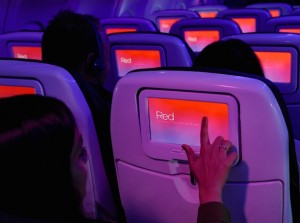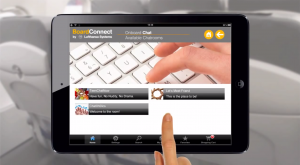These wonderful IFE innovations have already hit the market – and, are being utilized currently or being rolled-out in the near future. All the more reason for us to take flight and enjoy those friendly skies!
5 AIRPLANE ENTERTAINMENT SYSTEMS THAT WILL MAKE YOU FORGET YOU’RE FLYING COACH
By Les Shu — July 10, 2015
How do you keep your passengers happy? Whether it’s the spacious nose of the plane or the tightly packed tail end, one solution is to offer on-board entertainment. Hopefully the live television or blockbuster movie would alleviate the discomfort of a tight seat.
In-flight entertainment (IFE) on new planes no longer means staring into tiny, hard-to-see overhead monitors. They have become sophisticated seat-back computers loaded with more movies than most multiplex cinemas, or wireless setups that stream content to your smartphone or tablet. But it isn’t just about movies or music anymore: IFE systems now include Internet connectivity, interactive maps, and even surround-sound audio. And you don’t need a premium class ticket to enjoy some of them.
We take a look at the latest in IFE systems. And unlike these in-flight concepts, the technologies you see here already exists, and most are either in service or being rolled out.

Virgin America Red IFE System
Virgin America Red Beta
Virgin America is currently testing a new version of its Red IFE system on three aircraft. Running off on a modified version of Android and using Panasonic’s new EcoV2 monitors, the capacitive touch experience will feel more like a tablet, which means less hard presses on the screen and the ability to pinch and zoom. Resolution is only 720p, but it’s sufficient for a small screen size; Virgin America says the new IFE renders faster, so movies and games will look more fluid. The new system also has larger storage – three-times more content – and maps are more interactive.
But what’s revolutionary is the audio. Virgin America is working with audio-tech startup Dysonics to bring surround sound to all passengers. In order to do this, Dysonics encoded all the content to simulate a 3D sound experience. What’s awesome is that it is designed to work with any headphones, and it’s being rolled out on planes with both the old and new Red systems.
For Virgin America, the benefits of an Android-based IFE “gives us the ability to iterate much more quickly” – rather than decades, says Ken Bieler, director of Cabin Systems, Product Design, and Innovation.
The airline says Red Beta will be available on 18 planes by year’s end, and will complete rollout by 2016. The news was followed by Virgin America’s announcement of faster Wi-Fi via ViaSat’s Exede in the Air, which is 10-times faster than conventional systems. Calling itself the airline of Silicon Valley, Virgin America continues to be the techiest of all domestic airlines.
Our take: Unless you have noise-cancelling headphones, anyone who’s flown knows how annoying cabin noise is when you’re trying to watch a movie. The ability to hear better sound through the cheapest headphones is a triumph. What’s even better is that these new technologies are actually being rolled out.

Panasonic Jazz Seat IFE. Les Shu/Digital Trends
Panasonic Jazz Seat
Working with B/E Aerospace, Teague, and Formation Design, Panasonic Avionics’s Jazz Seat concept was a finalist for a 2015 Crystal Cabin Award. Panasonic gave us a tour of the product at the 2015 International CES Show (read more about it), and while the seat itself felt comfy, it was the IFE system that’s the star. The next evolution of Panasonic’s X Series, the large 13.3-inch display has a tablet-like touch interface with great viewing angles. High-definition audio is channeled through USB or regular headphone jack, and there are plenty of ports for HDMI and USB. There’s even wireless charging and NFC to handle mobile payments. More importantly, perhaps, is a “do not disturb” feature.
For the airlines, the IFE system uses a thinner display and it’s lighter, able to accommodate the slimmer seats that are being introduced. It’s a premium IFE experience, but in coach.
Our take: The Jazz Seat, so far, is still a concept. No airlines have committed to the product. As Panasonic tells us, airlines plan far in advance, so by the time the seat makes it onto a plane, the technology may already be outdated. But the Jazz Seat is also a showcase of what’s possible, so we may see traces of the tech in the near future.

Lufthansa Board Connect
Lufthansa BoardConnect
BoardConnect is Lufthansa Systems’ name for its onboard streaming-based IFE system. Using Wi-Fi, passengers can access entertainment from their own devices. But it also allows Lufthansa or any other airline to utilize off-the-shelf tablets in lieu of more expensive hardware and wiring (except power). The customized tablets can be easily integrated into seats, and an airline can quickly upgrade the hardware when newer, faster tablets are available. Besides media content, BoardConnect software can provide passengers with additional info and services, like making hotel reservations.
Our take: Described as a future-proof infotainment system, BoardConnect is similar to other BYOD solutions. We like that it recognizes that not everybody carries a personal device onboard – children, for example – yet it’s able to still deliver entertainment in a cost-effective manner. However, in place of hardwire, the plane will need a robust wireless system for all that data. Some airlines, like British Airways’ OpenSkies, pass out pre-loaded iPads to passengers; they don’t stream content, but hopefully they’re jam packed with enough entertainment to last a trans-Atlantic flight.

Gear VRheadset
Qantas Samsung Gear VR
While the economy section is getting trickled down technology that was once reserved for upper-class cabins, the front of the plane is playing with the future. In a trial, Australia’s Qantas partnered with Samsung to offer elite passengers to experience onboard virtual reality using the Gear VRheadset. Users were able to watch movies and experience virtual travel in 360 degrees.
“Whether the user wants a virtual tour of our new Los Angeles First Lounge or experience an A380 landing from the tarmac, this technology gives us a completely new way to connect with our customers,” says Olivia Wirth, Qantas’ group executive, in a release. “It’s also a fantastic tool to feature our network’s destinations, inspiring travel and promoting tourism.”
Our take: We aren’t sure about the appeal of virtual reality in this scenario, but consumer VR is in its infancy. Still, first-class cabins are already intimate enough, so do passengers really need to close themselves off even more? VR can deliver an immersive experience, but the video quality needs to be super – a poorly rendered one can instill discomfort, which is the last thing you need on a plane.

KLM Meet and Seat
KLM Meet and Seat
Sometimes the best onboard entertainment is the person next to you. Flying can be a lonely affair, but what if you knew a bit about the stranger sitting next to you? KLM is using social media – Facebook, Google+, and LinkedIn – to help passengers connect with one another (for privacy, you have to authorize). Once you get to know someone on the flight, you can pull up a seat map and sit with each other – perhaps a potential business partner or someone who made you laugh on Facebook. The idea is that knowing a fellow traveler can help you pass the time.
Our take: The idea can result in two scenarios: you meet a future friend, or you regret ever signing up for it. As lonely as flying can be, for some that private time is precious, and would rather not spend the duration of the flight entertaining a seatmate (Virgin America’s Red IFE has a chat feature that allows you to send a message to another passenger. From our experience, we’ve never seen anybody use it). Luckily, the Meet and Seat feature is optional.
